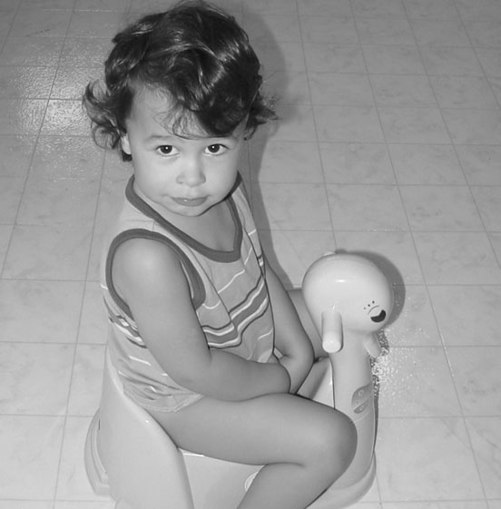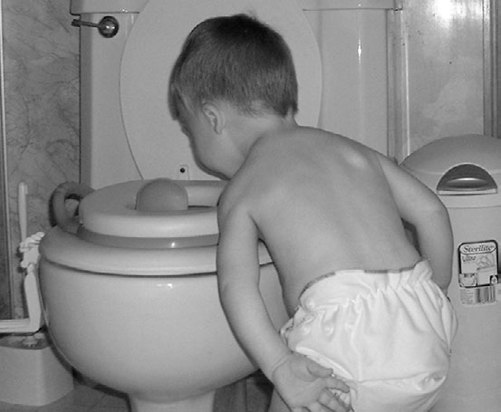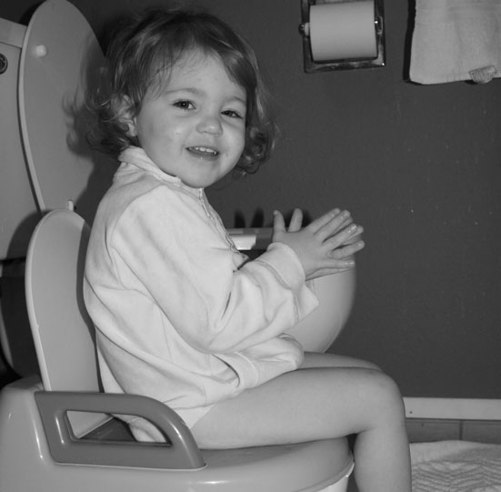The No-cry Potty Training Solution (20 page)
Read The No-cry Potty Training Solution Online
Authors: Elizabeth Pantley

There are a number of reasons that little boys miss the toilet. Often it takes too long to pee and they get bored, so they begin to look around—and the body follows their eyes and head, so they miss the toilet.
On occasion, a toddler is too small to be standing up to urinate, which makes it difficult for him to aim properly. If this is the case with your son, you can have him sit backward on the seat to pee until he’s a little taller.
Your son might be waiting too long to use the toilet, and then he has to rush to get to the bathroom, so he’s hurrying to get his pants down. To complicate matters, once he starts going, the force of his stream is strong, causing a wild spray and splashes.
Sometimes the problem is simply that no one has shown him how to point his penis down to keep the

Common Questions and Sensible Answers
141
Kahlil, two years old
spray directed properly into the bowl. A discussion and demonstration, followed by several reminders, can solve this.
Whatever the case, it’s annoying to have to constantly clean little puddles off the floor! Further, letting this continue without addressing it may create bad habits.
First, I would suggest that you talk to your son about the importance of aiming into the toilet, and point out what happens when he doesn’t. You might even use 142
The No-Cry Potty Training Solution
some fun aiming ideas, such as throwing a few Cheerios or potty-time targets into the bowl.
Finally, get him involved in the cleanup. Have him help wipe up his own mistakes, and he’ll quickly learn to aim into the bowl.
As long as we’re on this topic, here’s a reminder to teach your little guy from the start to lift the lid all the way up before peeing and then lower it back down when he’s done. It prevents unpleasant surprises for the next person using the toilet and, if taught from the start, will become a very polite habit.
Urinary Tract Infections (UTI)
My little girl has been using the bathroom more often than
usual the past few days, but each time she goes just a little
bit or sometimes not at all. She’s also complaining that it
hurts when she pees. Could she have an infection?
It is very possible this is the case. Infections of the bladder and kidney are common in young children, particularly girls. These infections are caused by bacteria and are usually not contagious.
Whenever you suspect an infection, you should make a call to your health care provider, who can help you determine if there is an infection. Some of the most common signs of a urinary tract infection are:
• frequent, small-volume urination
• an urgent need to urinate resulting in a dry run
• painful urination, often described as “burning”
• blood in the urine
• a fever
Common Questions and Sensible Answers
143
• abdominal pain or tenderness
• lower back pain
• urine that has an unusual or foul odor
• fussiness and irritability
A medical professional will review your child’s symptoms, examine your child, and take a urine sample to determine if an infection is present. If it is, antibiotics will likely clear things up quickly.
While you can’t totally prevent your child from ever getting a urinary tract infection, the following may reduce the likelihood:
• Make certain you teach your daughter to wipe
from front to back to avoid spreading bacteria.
• Keep your uncircumcised boy’s foreskin clean.
• Change diapers, training pants, or underwear as soon as they are wet or soiled.
• Make sure your child urinates often, and avoid having her hold it if she has to pee.
• Encourage your child to sit on the toilet long enough to empty her bladder.
• Avoid giving your child soapy bubble baths.
Handling Unwanted Advice
My grandmother is on a campaign for us to potty train our
daughter. She claims that in her day, all children were potty
trained by their first birthday, and our daughter is almost
two! Here’s the problem: we don’t think our daughter is
ready, and we know we aren’t either. How do we handle the
friction over this issue?
144
The No-Cry Potty Training Solution
This is definitely one of those issues that are a reflection of the times. Fifty years ago more than 90 percent of children were potty trained by eighteen months of age.
To be clear, I should actually rephrase that to make it more accurate: 90 percent of
mothers
were reliably putting their children on the toilet by the time their children were eighteen months old. In today’s world, unless a family is practicing infant elimination communication, the average age for a child to
begin
potty training is a wide span from eighteen to thirty-two months of age, with completion occurring between the ages of two and a half and four. Today the most common indicator of when to begin potty training is a child’s readiness to begin. However, this evolution of approaches may be something the other generation doesn’t know about or doesn’t agree with.
You can respond to unwanted advice from your
grandmother, or from anyone else who has a different viewpoint on potty training, in a variety of ways. The method that you choose will depend upon your personality, your mood, and your relationship with the advice giver. Here are a few options:
•
Provide information.
You may want to acknowledge to her that things were done differently when she was raising her children. Explain that today’s research tells us that potty training is easier and less stressful for everyone if you wait until a child is physically and emotionally capable of actively participating in the learning process.
•
Quote a doctor or a book.
Many people accept your point of view if a medical professional or published
Common Questions and Sensible Answers
145
book has validated it. Simply say, “My doctor said to wait a few more months before we start training.” Or,
“I’m currently reading a book on the topic to set the best plan for us.”
•
Tell her that you’re starting.
Lots and lots of pre-potty training activities are outlined in Chapter 3, and it’s likely you’re already doing some of these. Mention that you’ve already started the process.
•
Politely disregard.
This is a helpful approach if you know that there is no convincing the other person to change her mind—she has already raised her children this way and is imparting “you should, too” kind of advice. Simply smile, nod, and make a noncommit-tal response, such as, “Really? Interesting!” Then go about your own business in your own way.
•
Steer clear of the topic.
If you’ve tried to educate or disregard to no avail, then diversion or distraction is definitely in order. Whenever the topic comes up, swiftly change the subject: “Would you like a muffin? I just bought them and they’re delicious. . . .”
Playing with Poop
I’m embarrassed to even ask this question, but I will. I
walked in on my newly potty trained son, and he was finger painting with his poop! He had taken it out of the potty
and spread it all over the floor. I was really shocked, and I
yelled at him the whole time I cleaned it up. I’m still worried about it. Is this normal behavior?
Yes, believe it or not, this is perfectly normal behavior.
Children don’t have the same inhibitions and distaste

146
The No-Cry Potty Training Solution
Orrin, nineteen months old
that we adults have about normal bodily waste. A newly potty trained youngster may be intrigued with what his body has produced and be curious about it. Many wave bye-bye to their stool before they flush, and it’s not unusual for a child to call a parent to show off a particularly interesting creation in the toilet! Some even go so far as to touch or taste their final product, something we adults find distasteful. (Bad pun intended.) The best way to handle this is to keep your own emotions in check and explain to your child what we do and don’t do with our waste. Tell him that poop has germs in it that don’t belong on hands, and then wash him up thoroughly. Supervise your child when he uses the bathroom for a while to be sure he doesn’t give in to the urge to finger paint again.
Common Questions and Sensible Answers
147
Constipation
My son gets constipated, mainly because his diet is very limited. He only eats macaroni and cheese, peanut butter and
jelly sandwiches, and cookies or muffins! He won’t go near
fruit, vegetables, or whole grains. Any ideas?
In this case it is right to assume that diet is the reason for his constipation. This can delay potty training, and it can cause health problems as well. It is important to work healthier foods into your child’s diet. Until he grows out of this picky-eating stage, you can do this in creative ways to get past his choosy palate. Here are a few ideas:
• Substitute half of his regular macaroni with whole wheat pasta. When mixed with the cheese sauce,
he likely won’t even notice it.
• Make his sandwich with one side of his regular bread and one side with whole wheat bread. Place it on his plate with the familiar bread facing up.
Substitute high-sugar jelly with all-fruit spread.
Add a side dish of fruit or veggies.
• Make homemade popsicles out of fruit and veg-
etable juices, pureed fruit and vegetables (apple and carrot is a good mix), or yogurt. Kids love popsicles, and your son will think he’s getting a treat, when you’ll know it’s good for him.
• Shop around for healthier cookies or muffins—you can find some made with applesauce, carrots, or zucchini. Or make these at home so that you can control the ingredients.
• Present fruit or vegetables cut into bite-sized pieces with a sauce for dipping, such as yogurt or salad dressing.
148
The No-Cry Potty Training Solution
Training an Active Toddler
My active daughter won’t sit still for a moment! Getting her
to stay put on the potty long enough for something to happen is a real challenge. How do I get her to stay seated?
For some active children, when potty training first begins, it’s all about keeping them seated long enough to catch a bit of success. After a few successful episodes, your child will understand the purpose for sitting on the potty, and she’ll likely be more cooperative.
For your child to have success on the potty, she must sit still and her body must be relaxed. You can help her by doing any of the following while she’s seated:
• Read to her.
• Sing with her.
• Tell stories.
• Give a puppet show.
• Paint her fingernails or toenails.
• Play word games, such as I spy.
• Listen to music or a child’s audiobook.
• Chat about the day.
• Set an egg timer to indicate how long she should sit.
You can also encourage success by offering your child lots of fluids and then taking her to the potty when she’s most likely to go—when she first wakes up, every one and a half to two hours throughout the day, twenty to forty-five minutes after drinking, plus anytime she gives signals that she needs to go (see page 68).
Don’t force a new trainee to sit so long that she becomes upset or angry. This will just backfire and make the whole potty training process miserable for everyone.

